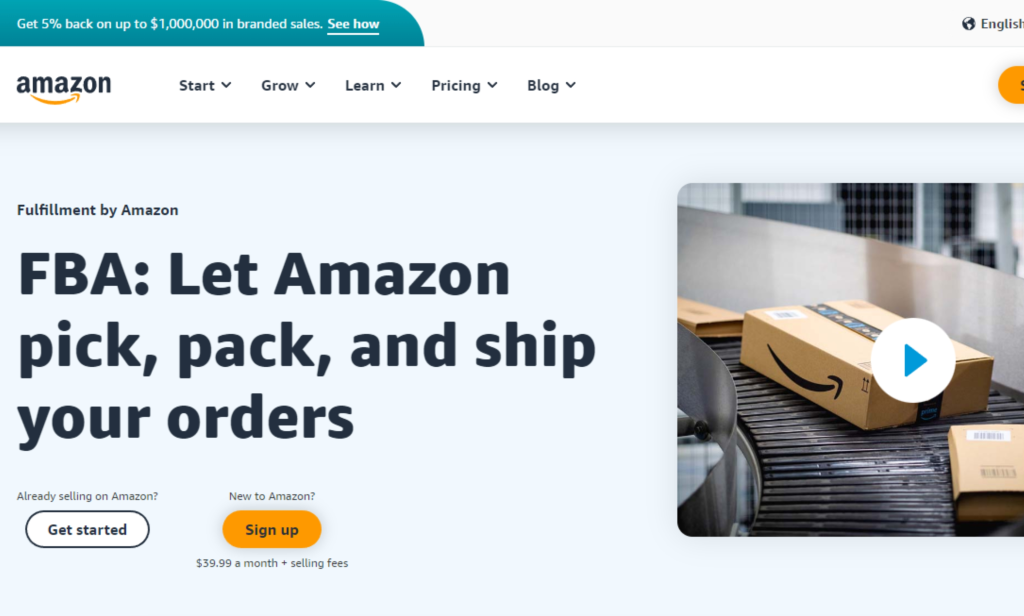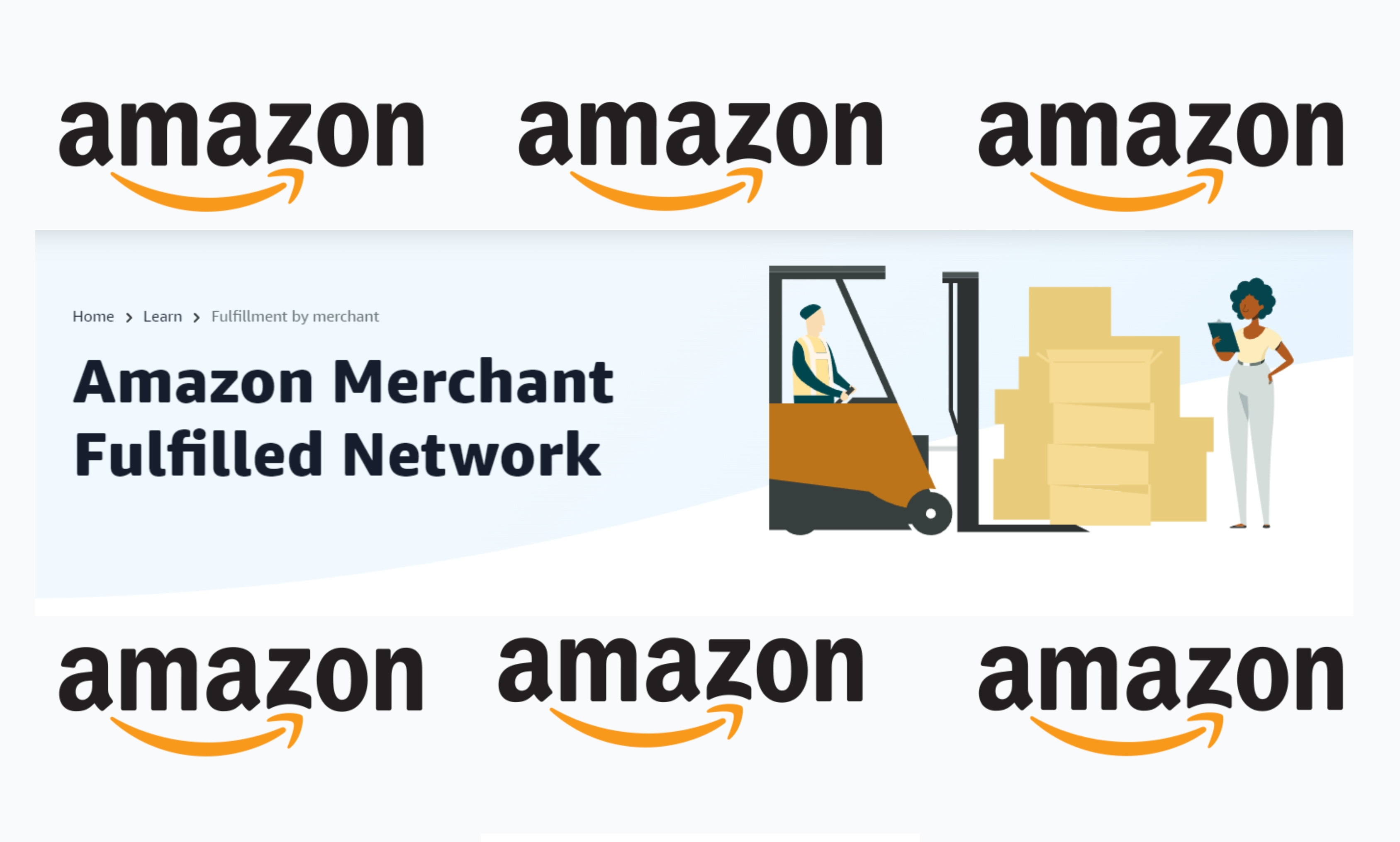Seller Fulfilled Vs Amazon Fulfilled are two popular fulfillment options for merchants selling on Amazon, but which one is right for you? Your choice of fulfillment method can have a huge impact on your business. It determines the cost of goods and shipping, as well as the speed at which products arrive to customers. And most importantly, it affects the customer experience.
In this article, we’ll break down the differences between Seller Fulfilled and Amazon Fulfilled to help you decide which is right for your business. We’ll cover every aspect of both options, from costs to convenience. But first, let’s start with a quick overview of Seller Fulfillment by Amazon and Amazon FBA.
What Is Amazon FBA?

It’s a service offered by Amazon for businesses to take the hassle out of product delivery. That means that rather than having to set up their own infrastructure for storing, packing, and shipping items, businesses can send their stock to Amazon’s warehouses around the world.
From there, Amazon will manage everything from packaging and shipping orders made on its Marketplace all the way through customer service and handling any returns. This revolutionary technique has helped thousands of entrepreneurs run their businesses without worrying about logistics – instead, they can concentrate on growing and developing new products, leaving mundane logistical tasks in safe hands with Amazon FBA.
Key Features Of Amazon FBA
Now that you know what Amazon FBA is and how it works, let’s take a look at the key features it offers.
- High Quality and Fast Delivery: Amazon FBA offers fast, reliable delivery of your products through Amazon’s fulfillment centers, ensuring that customers receive their orders quickly and in excellent condition.
- Low Shipping Costs: With Amazon FBA, you’ll pay low shipping costs for product delivery since Amazon is able to negotiate better rates with carriers.
- Hands-Off Logistics: With Amazon FBA, all you have to do is send your products to Amazon’s warehouses and they’ll take care of the rest. That means no more worrying about packing, shipping, or returns processing – Amazon takes care of it all!
- Scalability: If you’re looking to scale quickly, Amazon FBA can help you achieve that. They have warehouses all over the world, so you can easily expand your business and ship products to customers in different countries.
- Reliable Customer Service: Amazon FBA has a reliable customer service team that can handle any queries or issues from buyers quickly and efficiently.
These are just some of the advantages of using Amazon FBA – there are many more, so be sure to do your research before making a decision.
Cons Of Amazon FBA
Like anything, there are also downsides to Amazon FBA. Here are some of them:
- Heavy Fees: Amazon will charge you a monthly service fee and per-item fees for using their services. This can get expensive if you’re selling in bulk or have high-volume orders.
- Third-Party Control: You don’t have full control over the process. Amazon will manage the fulfillment process, meaning you won’t be able to customize it to your own needs.
- Long Wait Times: Shipping times can take longer than Seller Fulfillment due to extra processing and handling by Amazon.
These are just a few of the cons. As with any service, make sure you do your research and weigh up the pros and cons before making a decision.
What Is Seller Fulfilled?

Seller Fulfilled is a fulfillment option for businesses that want to take full control of their own product delivery. This option requires merchants to store and manage the products themselves, from packaging and shipping orders to customer service and returns.
This choice gives the merchant complete control over the process, and they can use whatever delivery methods they choose. That means that the merchant can decide how to ship products, what speed of delivery to offer, and how much to charge for shipping. However, this extra responsibility also comes with a few drawbacks – like needing to factor in additional fees and costs associated with handling logistics yourself.
Key Features Of Seller Fulfilled
Let’s take a look at the key features of Seller Fulfilled:
- Full Control Over Logistics: With Seller Fulfilled Prime (SFP), you have full control over your own logistics in your own warehouse. That means you can decide how to ship products, what speed of delivery to offer, and how much to charge for shipping.
- Lower Costs: With Seller Fulfilled, you don’t have to pay Amazon’s storage and pay fulfillment fees. That can mean lower overall costs for your business if you manage your logistics yourself.
- Flexibility: If you’re looking for more flexibility with your delivery options, then Seller Fulfilled is the way to go. You can customize your delivery methods to meet customer needs and preferences, and you can adjust as needed.
- Scalability: If you’re looking to grow your business quickly, Seller Fulfilled gives you the flexibility to do so without worrying about Amazon’s storage or fulfillment fees.
These are just some of the advantages of Seller Fulfilled – there are many more depending on your business needs.
Cons Of Seller Fulfilled
Of course, like any service, there are some drawbacks to Seller Fulfilled. Here are a few of them:
- Time-Consuming: Managing your own logistics can be time-consuming and require extra staff. That means you’ll need to factor in additional costs for labor, packaging, and shipping materials.
- Risk Of Damaged Goods: Shipping products yourself means you may be at risk of damaged goods or lost packages. That can mean an increase in customer complaints and returns which can cause further delays and impact your reputation.
- Potential For Delays: If there are any issues with your shipping process, it can lead to delays in delivering products to customers – leaving them unhappy and potentially impacting your reputation.
- Increased Costs: You’ll need to factor in costs associated with handling logistics yourself, including packaging and shipping materials as well as labor costs.
Although there are some drawbacks, Seller Fulfilled is still a great option for many businesses – especially those looking for greater control over their logistics process. Only the Amazon prime badge will be missing, but with careful planning, you can still meet customer expectations.
What Are The Similarities Between Seller Fulfilled and Amazon FBA?

Now that you know the key features of Amazon FBA and Seller Fulfilled, let’s look at what they have in common.
- Both options allow merchants to control their own logistics through any of this merchant-fulfilled network, meaning they can choose how to ship products and decide on delivery times and costs.
- Both options offer scalability, meaning merchants can quickly expand their business and reach more customers in different countries.
- Both options require the merchant to handle customer service, returns, and other related issues themselves.
- Both options have their own advantages and disadvantages depending on the needs of each business.
These are just some of the similarities between Seller Fulfilled and Amazon FBA. Ultimately, it’s up to you to decide which option is best for your business – so be sure to research them both before making a decision.
What Are The Differences Between Seller Fulfilled and Amazon FBA?
After comparing the similarities between Seller Fulfilled and Amazon FBA, let’s look at what sets them apart.
1. Fulfillment Fees

Amazon FBA will charge a variety of different fees depending on the size and weight of the item, as well as additional services like shipping and returns. These fees can really add up if you’re selling a lot of products with various sizes/weights. On the other hand, Seller Fulfilled orders don’t involve any fulfillment costs from Amazon itself.
However, you will still be responsible for your own packaging and shipping costs. The upside of this is that you have flexibility on your sales channels when it comes to negotiating rates and services with carriers, allowing you to potentially save money.
2. Inventory Management
Amazon FBA manages your inventory for you, and they are also responsible for picking, packing, and shipping orders. Seller Fulfilled orders on the other hand require you to take care of all of this yourself because you have to manage the stocking and shipping of your own products. This requires a lot more work, so you need to be sure that you have the time, effort, and resources necessary before taking on this option.
With Amazon FBA, you can have peace of mind knowing that your products are in good hands and will be shipped out on time. However, this comes at a cost — fees for using the service — so it’s important to factor those into your internal calculations when deciding which option is best for you.
3. Time To Market And Buyer Expectations

Amazon FBA orders have faster delivery times due to Amazon’s expansive network of warehouses, so they can typically get items fulfilled and shipped more quickly than if you were to do it yourself. This is important because buyers expect fast delivery when ordering from Amazon, so this could give you a competitive advantage.
Despite that, Amazon Seller Fulfilled Prime orders can be a bit slower due to the need for you to manage the inventory and shipping yourself. This may not matter if your target buyers don’t expect fast delivery times, but it’s something to consider for Amazon prime sellers if speed is important.
4. Control Over Order Fulfillment
In Amazon FBA, you cede control of your order fulfillment process to Amazon. But with Seller Fulfilled orders, you can have more control over the entire process and make customizations like special packaging or personal messages that buyers will appreciate. This extra level of service can go a long way toward creating a memorable customer experience.
Seller Fulfilled orders also provide more control over how quickly orders get shipped out. You can set up a schedule that works for you and your customers, allowing you to make sure all of your orders are fulfilled in a timely manner. Additionally, most third-party shipping options offer discounts on items like express delivery or other premium services.
5. Returns

When it comes to returns, Amazon FBA is a bit easier as they will handle the entire process for you. With Seller Fulfilled orders, you will have to manage the return yourself. This means that you need to be prepared and understand how your refund policies work, as well as provide clear instructions in case of returns. It may also be beneficial to have a process in place for dealing with customer complaints and returns efficiently so that it does not become a time-consuming task.
One advantage of Seller Fulfilled orders is that you can offer more flexible return policies than Amazon FBA, as you are responsible for the entire process yourself. Having a more lenient return policy can be a great way to attract more customers and build loyalty, as long as you communicate the policy clearly. Amazon buys shipping services are also available to make the process easier.
6. Inventory Accuracy
Inventory accuracy is essential when fulfilling orders, and this is where Amazon FBA may have an edge. With Seller Fulfilled orders, it’s entirely up to you to make sure that your inventory is accurate at all times — which can be difficult if you’re not used to managing stock levels. This means that you need to be on top of all inventory changes, as even a small error can lead to unhappy customers.
On the other hand, Amazon FBA orders are managed by Amazon’s own systems, so you can rely on their accuracy and efficiency when it comes to managing stock levels. This takes away some of the burdens from you while still providing excellent service to customers.
Conclusion
Seller Fulfilled vs Amazon FBA: which is right for you? This question can be hard to answer as both options have their own benefits and drawbacks. You will need to consider all the above factors, as well as your own unique goals and resources before deciding which fulfillment method is right for you. Ultimately, the best way to learn which option will work best for you is by experimenting and exploring both methods to determine what works best for your business.
Once you have a better understanding of the differences between Seller Fulfilled and Amazon FBA, you can make an informed decision on which fulfillment option is the best fit for your business.
Be sure to check out our other e-commerce guides.

